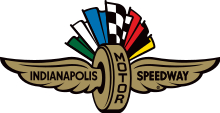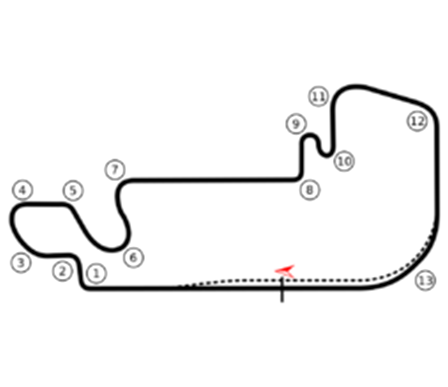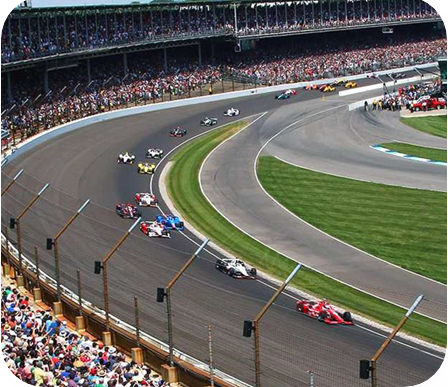
Location: Speedway, Indiana, United States
Indianapolis 500 Fastest speed: (Recorded during 1 lap practice) May 10, 1996, Arie Luyendyk 239.260 mph (385.052 kmh) driving Reynard formula Indy.
Indianapolis 500 Fastest Lap: (Recorded during 1 lap practice) May 10, 1996, Arie Luyendyk 0:37.6160
United States Grand Prix Fastest speed: Recorded during 1 lap practice) June 19, 2004, Rubens Barrichello 135.025 mph (217.302 km/h) driving Ferrari F2004
United States Grand Prix Fastest Lap: (Recorded during 1 lap practice) June 19, 2004, Rubens Barrichello 1:09.454
It is the home of the Indianapolis 500 and the NASCAR’S Verizon 200, and formerly the home of the United States Grand Prix and Moto GP, built in 1909, it is a banked oval racing circuit and the first to be called a 'speedway'.

It is the third-oldest permanent automobile racetrack in the world and with a permanent seating capacity of 257,325, it is the highest-capacity sports venue in the world.
The track is a 2.5-mile-long (4.0 km) rectangular oval: it has two 5⁄8-mile-long (1,000 m) straightaways, four geometrically identical 1⁄4-mile (400 m) turns, connected by two 1⁄8-mile (200 m) short straightaways, termed "short chutes", between turns 1 and 2, and between turns 3 and 4.
Paving bricks — 3.2 million of them — once covered the entire 2.5-mile oval, but over time different sections of the racing surface have been paved. Since 1961, a 3-foot wide section at the start/finish line still has bricks. Hence, the terms "Yard of Bricks" and "Brickyard."
Indy 500 winners kiss the bricks. The Indy 500 borrowed this tradition from NASCAR's Brickyard 400. Dale Jarrett kissed the bricks after his 1996 victory, and Gil de Ferran picked it up for the 2003 Indy 500. Now, everyone who wins at the facility — car racers, air racers, golfers — make sure they kiss the bricks.
A modern, FIA Grade One infield road course was completed in 2000, incorporating part of the oval, including the main stretch and the southeast turn, measuring 2.605 mi (4.192 km). In 2008, and again in 2014, the road course layout was modified to accommodate motorcycle racing, as well as to improve competition.
The Grand Prix circuit ran clockwise, unlike the oval circuit, and spanned around half the oval circuit, using the same pit area as the oval track. The first two corners are at 90° angles, the first a very tight right-hander (Turn 1), then a wider left-hander (turn 2). Three right-hand bends follow, the first a long 60° sweeper (Turn 3), the second tighter 120° with an increasing radius (Turn 4), the third a fast 45° kink (Turn 5). Turn 6 is a long 180° left-hander that lead directly into the increasing radius 120° Turn 7. The back straight followed, before a 90° left turn (Turn 8) which led into two slow 180° hairpins, the first slightly tighter than the second (Turns 9 and 10, colloquially known as "Mickey" and "Mouse", names that infuriated the IMS management). At the next corner, Turn 11, the cars started building up speed as the cars rejoined the oval track at turn 12. Turn 13, the only banked corner on the F1 calendar at the time, was taken flat out and this led to the start/finish line. Pit in was between turns 12 and 13, but a slow car could make an entrance at the exit of 13.
The banked corner, Turn 13 was the source of the problems that arose at the 2005 United States Grand Prix, because the Michelin tyres provided were not able to survive ten laps unless there was a reduction of speed on the corner, as Ralf Schumacher's accident testified. Bridgestone had no problems with the banked corner, as they also provided tires for the Indy Car series, and routinely made tires designed for banked ovals. Eventually, the fourteen Michelin runners chose to withdraw after the formation lap in the interests of safety, leaving the remaining six Bridgestone runners to race it out. After the tyre scam, Michelin opted to refund those fans who went to the race and that they would purchase 200 tickets to give for free for the 2006 United States Grand Prix. The corner that was Turn 13 has since been replaced from the Indianapolis road course by a short right/left/right infield loop.a reduction of speed on the corner, as Ralf Schumacher's accident testified. Bridgestone had no problems with the banked corner, as they also provided tires for the Indy Car series, and routinely made tires designed for banked ovals. Eventually, the fourteen Michelin runners chose to withdraw after the formation lap in the interests of safety, leaving the remaining six Bridgestone runners to race it out. After the tyre scam, Michelin opted to refund those fans who went to the race and that they would purchase 200 tickets to give for free for the 2006 United States Grand Prix. The corner that was Turn 13 has since been replaced from the Indianapolis road course by a short right/left/right infield loop.
source:https://f1.fandom.com/wiki/Indianapolis_Motor_Speedway
source:https://sportsmatik.com/sports-corner/sports-venue/indianapolis-motor-speedwa
edit by: Ascari


